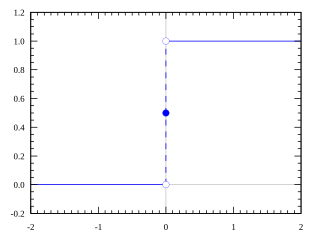Heaviside function
discontinuous function whose value is zero for negative numbers and one for positive numbers From Wikipedia, the free encyclopedia
Remove ads
The Heaviside function, often written as H(x), is a non-continuous function whose value is zero for a negative input and one for a positive input.

The function is used in the mathematics of control theory to represent a signal that switches on at a specified time, and which stays switched on indefinitely. It was named after the Englishman Oliver Heaviside.
The Heaviside function is the integral of the Dirac delta function: H′(x) = δ(x). This is sometimes written as[1]
Remove ads
Discrete form
We can also define an alternative form of the Heaviside step function as a function of a discrete variable n:
where n is an integer.
Or
The discrete-time unit impulse is the first difference of the discrete-time step
This function is the cumulative summation of the Kronecker delta:
where
is the discrete unit impulse function.
Remove ads
Representations
Often an integral representation of the Heaviside step function is useful:
Remove ads
H(0)
The value of the function at 0 can be defined as H(0) = 0, H(0) = ½ or H(0) = 1. In particular:[2]
Related pages
- Laplace transform
- Step function
References
Wikiwand - on
Seamless Wikipedia browsing. On steroids.
Remove ads


![{\displaystyle H[n]={\begin{cases}0,&n<0\\1,&n\geq 0\end{cases}}}](http://wikimedia.org/api/rest_v1/media/math/render/svg/efb65c686bdec46712eae1997c363f7ef8709b79)

![{\displaystyle \delta \left[n\right]=H[n]-H[n-1].}](http://wikimedia.org/api/rest_v1/media/math/render/svg/e6c417f161a7987a4db18818743eeb23494b0feb)
![{\displaystyle H[n]=\sum _{k=-\infty }^{n}\delta [k]\,}](http://wikimedia.org/api/rest_v1/media/math/render/svg/5db28db3163e2940aaf93d0fc180edb19d865d32)
![{\displaystyle \delta [k]=\delta _{k,0}\,}](http://wikimedia.org/api/rest_v1/media/math/render/svg/97a99ab7d257c74f38fbb2d42c8e42e1cb16d0e9)

